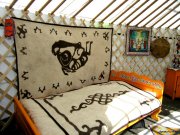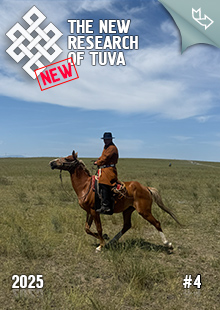 The former successful mathematics teacher of Elista intermediate school No.3, Ekaterina Adyayeva, after she left for her well-deserved retirement, was not confused, as so often happens in our times. Since she knew how to do practically everything at home with her own hands, she became involved in in learning folk crafts - Kalmyk embroidery and a type of handicraft that is very exotic today - felt-making.
The former successful mathematics teacher of Elista intermediate school No.3, Ekaterina Adyayeva, after she left for her well-deserved retirement, was not confused, as so often happens in our times. Since she knew how to do practically everything at home with her own hands, she became involved in in learning folk crafts - Kalmyk embroidery and a type of handicraft that is very exotic today - felt-making.
- I became enthusiastic about felt-making the first time I saw it done, - says Ekaterina Lidzhievna. - in winter of 2009, together with doll-maker Elena Lukina,, we took part in an international symposium "The art of felt in the Turkic world: history and the present", which took place in Kazan.
Not just folk craftsmen were there - there were scientists, scholars and officials, who were all seriously interested in the rebirth of felt-making.
It was sad to hear that this type of decorative-applied art belongs to Bashkirs and Tatars. After all, this is a traditional occupation of many nomadic peoples, including the Kalmyks.
Even quite recently, in the first half of last century, every Kalmyk family used to make felt for its domestic needs. They made shirdyks (rugs), travel bags, quivers for arrows, horse saddle-cloths, stockings.
- So, to learn the secrets of Kalmyk felt-making, - Ekaterina Lidzhievna Adyayeva continues, - when I got home I went to the museum right away, where I learned about the samples of old felt artifacts.
After reading all existing literature on the subject, she consulted with scholars - art historians, and traveled to the village of Ketchenery to visit Dordzhi Nandyshev, one of the few Kalmyks who know how to make felt. At the same time she, together with the traditional Kalmyk way of felt-making(using water or sour milk), she also learned the contemporary method - "felting" (dry method) by which a drawing can be made on fabric of natural fiber, or toys, clothing, bijouterie and other things. Already a year later we went to Ufa with my daughter Delger, where we gave a workshop in felt quilting.
That particular technique is known only to us, Kalmyks, and to Western Mongols.
As Ekaterina Lidzhievna Adyayeva said, mostly she makes small panneau, handbags, eyeglass cases… The work is labor-intensive and takes up a lot of time, because everything is done by hand: from washing the wool to applying a Kalmyk ornament (www.KalmykiaNews.ru). That is why lately the craftswoman rarely does it. One after another, two grandsons were born. They need their grandmother's attention, and the daughter-in-law also has to look after them.
- I would very much like to find other people interested in this. Even though young people show interest, they come up at exhibitions where I show my things, they ask if it is easy to learn it. I held workshops for students at middle school No.10. But things don't move beyond simple curiosity, - complains the master.
True, Ekaterina Adyayeva believes that felt will get back its former popularity. After all, there is increasing demand in the world for things made of natural fibers. Even a technique of making silk with an applied pattern of wool has been worked out. If you add felt accessories decorated with Kalmyk embroidery, such clothing will be priceless.
At this time, Ekaterina Lidzhievna Adyayeva actively promotes souvenirs on folk themes for the local market (www.KalmykiaNews.ru).
In the little store that she opened with her daughter, products made by Kalmyk craftsmen are exhibited - dolls, pouches, etc. there are Kalmyk hats made and embroidered by Adyayeva herself. Next to these, there are women's adornments, made of beading by the younger proprietress. Anything that is needed for the handicraft can be obtained here - threads, needles, and such things.
Those who wish to can get not just a consultation here, but the first lessons in sewing, embroidery, and knitting as well. As Ekaterina Lidzhievna admits, she owes her ability to do all this to her parents - her mother Nadezhda Sangrayevna and father Lidzhi Tyurbeyevich Mukharev.
It was they who brought her up to love work and to live with dignity. In her turn, Ekaterina Adyayeva made sure that these qualities were also transmitted to her children, giving them more than just education.

